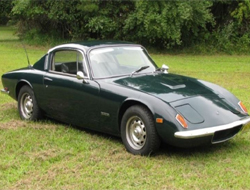Lotus Elan
 Key features of the Elan, new in 1962, were the chassis and engine. Unlike the glassfibre monocoque Elite that it replaced, the Elan had an unstressed glassfibre body mounted on a pressed-steel backbone chassis, forked at either end to provide engine and suspension mounting points. Disc brakes and all-round independent suspension – the latter developed with Lotus’ usual flair – meant the chassis could cope with plenty of power.
Key features of the Elan, new in 1962, were the chassis and engine. Unlike the glassfibre monocoque Elite that it replaced, the Elan had an unstressed glassfibre body mounted on a pressed-steel backbone chassis, forked at either end to provide engine and suspension mounting points. Disc brakes and all-round independent suspension – the latter developed with Lotus’ usual flair – meant the chassis could cope with plenty of power.
To provide it, Lotus boss Colin Chapman came up with a plan for a new engine to replace the expensive and temperamental Coventry Climax unit in the Elite. Chapman hired Harry Mundy to design a twin-cam conversion for Ford’s new Cortina engine, and sold Ford the idea of using the twin-cam powerplant both for his Elan and for a high-performance saloon (which became the Lotus-Cortina). Early engines were 1498cc but most were 1558cc, giving 106bhp from the start and up to 126bhp by the early 1970s.
By then the two-seater Elan – available in hardtop coupe and roadster forms – had been joined by a longer, wider two-plus-two coupe called the Elan +2. Though the +2 wasn’t quite as crisp to drive as the two-seater Elan, the extra space was useful and it could still cover the ground quicker than almost anything else.
The Elan continued until 1973, the last of them in big-valve Sprint form with two-tone paint (commonly red over white with gold stripes, Team Lotus’ Gold Leaf sponsor colours) and a very few with five-speed gearboxes. The +2 lasted little longer, being replaced by the bigger and faster Elite in 1974.